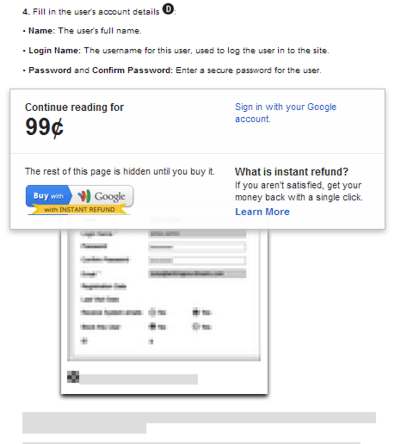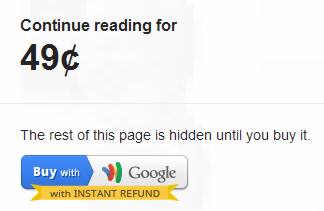| Google Experiments With Paying For Content |
| Written by Sue Gee |
| Monday, 08 October 2012 |
|
Google has launched an experiment in paying for online content using Google Wallet. Users are asked to pay less than a dollar in return for permanent online access. How will they react? The problem facing those who provide premium online content, i.e. content that is unrelated to the provision of goods and services, is how to enable it to pay for its creation. None of the current methods seems satisfactory. Advertising is one option - but relies on having really large volumes of traffic and at the same time deters many visitors and some users go to great lengths to block ads. Donation is another option but either seems inappropriate or unprofessional. Pay walls do work - for really well established publications like the New York Times and the Financial Times but Rupert Murdoch's experience with the tablet-based The Daily is an object lesson in the risks involved of trying to get enough subscribers to pay enough to launch a new venture. This experiment is currently $40 million in the red, a third of its staff was laid of at the end of July and it scheduled to be "reassessed" next month, after the US elections. So what about the idea of paying for content by the web page? This is the experiment Google is currently trialling. The idea is that you can read the start of an article, so that you can establish its relevance and its quality, but soon encounter redacted text and blurred graphics. To continue reading you need to pay a "small-change" amount of money.
While all web publishers are invited to sign up to use Google Wallet as a payment option for your online content, the examples provided are only from established and highly regarded content providers - Oxford University Press and Pearson. Oxford Reference has an article on Arctic Sea-Ice taken from a recently published book on Global Change. Having provided a couple of paragraphs and an informative table it asks you to purchase the rest of the text for 99cents. The redacted part of the document consists of 12 paragraphs followed by a section with a uniform format each culminated in a short line preceded by an arrow bullet point. It really wasn't rich enough to give much clue as to what to expect. The Pearson content is more extensive and also more open about indicating what is on offer for 49 cents per article. From it DK imprint it has selected titles to produce My DK Library with three "boutique sites" each for a distinct audience. In the Essential Managers series, you'll find multi-chapter books on ten topics including Project Management, Leadership and Green Business. At first, paying 49 cents for each of four chapters seems like a reasonable deal but if you want a paper copy then you'll find good deals for the bound versions. The Knitting Book has 10 modules so you'll pay just under $5 for the entire available content. This initially seems a reasonable buy given that the hardcover version is $40. However, the print book has 400 pages and so goes way beyond the get-you-started material online. Eighteen section of the Dorling Kindersley Natural History Book are also available and are likely to appeal to children being set homework tasks for their attractive pictures. Before you buy notice that you can probably find equivalent information online for free. The other Pearson books featured in this experiment are in the Visual Quickstart Guide series.
There are currently ten titles, each with material split into around 20 chapters - so you'll pay around $20 each which is probably only around 20% less than buying the cheapest available paper copy of the same book. So this may be a good test of whether people are prepared to buy this type of content in a piecemeal fashion for small change. It would also be good to see some unique content as part of the experiment - at the moment all the content provided is pre-existing and just gives consumers a low-risk way to sample the goods. Chances are that a high proportion of customers will end up asking for a refund of their small change and decide to make the bigger purchase instead. This tends to doom the experiment in terms of gauging web visitors willingness to buy content in return for micropayments, even if the scheme is a success in terms of the merchants' overall sales.
We have to hope that, having billed this as an experiment, Google tells us the results in due course. Is this sort of micropayment the way forward? Comments please. More InformationRelated ArticlesFlattr me - Micropayments yet again Two-thirds of Internet users have paid for content Signs of the times - paywalls do pay The Daily - how will it change epublishing?
Comments
or email your comment to: comments@i-programmer.info
To be informed about new articles on I Programmer, install the I Programmer Toolbar, subscribe to the RSS feed, follow us on, Twitter, Facebook, Google+ or Linkedin, or sign up for our weekly newsletter.
|
| Last Updated ( Monday, 08 October 2012 ) |






